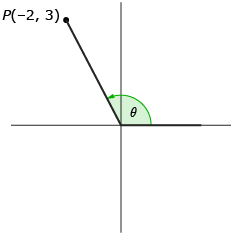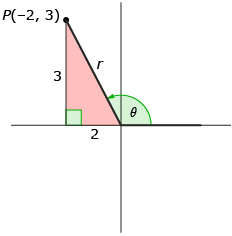Lesson 3
1. Lesson 3
1.5. Explore 4
Module 2: Trigonometry
Finding Angles from a Point on the Terminal Arm
In Try This 1 you were given the coordinates of endpoints on terminal arms of 0°, 90°, 180°, 270°, and 360° angles and asked to determine the cosine, sine, and tangent of these angles. This process can be extended to other angles where a point on the terminal arm of the angle is known. Consider the following example.
Point P(−2, 3) is on the terminal arm of an unknown angle, θ. Determine the exact values for cos θ, sin θ, and tan θ.
The first step is to draw a picture.

Recalling the primary trigonometric ratio definitions, you can write the following ratios:
The only piece missing is r, the distance from the origin to P(−2, 3). This can be determined by imagining that the terminal arm is the hypotenuse of a right triangle.

The Pythagorean theorem can be used to determine r.

The primary trigonometric ratios of this angle can now be written in full.
 |
Note that ![]() and
and ![]() are mathematically equivalent. By convention, the negative sign is normally written with the numerator.
are mathematically equivalent. By convention, the negative sign is normally written with the numerator.
Self-Check 2
Complete questions 3, 8.a., and 8.c. on page 96; and question 13 on page 84 of the textbook. Answers